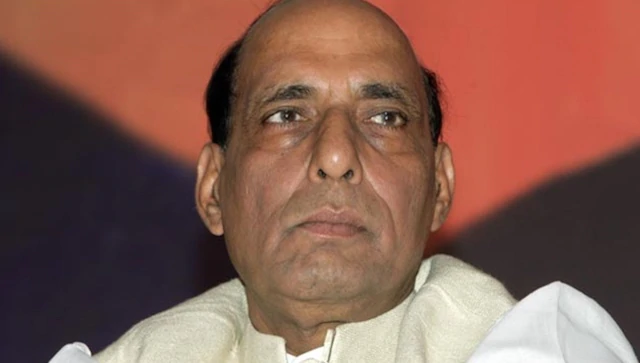
SOURCE: FIRST POST
On 9 August, Defence Minister Rajnath Singh fired off a barrage of 12 tweets signalling that India has seriously stepped up the gas on fulfilling its defence requirements indigenously.
“This decision will offer a great opportunity to the Indian defence industry to manufacture the items in the negative list by using their own design and development capabilities or adopting the technologies designed & developed by DRDO to meet the requirements of the Armed Forces,” Singh said. “The embargo on imports is planned to be progressively implemented between 2020 to 2024.
Our aim is to apprise the Indian defence industry about the anticipated requirements of the Armed Forces so that they are better prepared to realise the goal of indigenisation. All necessary steps would be taken to ensure that timelines for production of equipment as per the Negative Import List are met, which will include a co-ordinated mechanism for hand holding of the industry by the Defence Services,” he tweeted.
Although the announcements sound dramatic, they are neither new nor earth-shattering. On 16 May itself, Finance Minister Nirmala Sitharaman announced that the FDI limit in defence manufacturing under automatic route will be hiked to 74 percent from the existing 49 percent while some weapons and platforms will be banned for imports. There is a belief that global players like Lockheed Martin, Boeing, Airbus and Dassault Aviation will now set up manufacturing hubs in India and bring niche technology without hesitation as the firms will have majority stakes in their Indian subsidiaries.
Even if major global defence firms set up shops in India, there is no guarantee that they will transfer technology of their products which are technically their milch cow. She said that items banned for imports can only be purchased from within the country and that there will be indigenisation of some imported spares with separate budgetary provisioning for domestic capital procurement. This, she said, will reduce the huge defence import bill.
The finance minister also said that Ordnance Factory Boards will be corporatised for better management and eventually get listed on the stock market. For the time-bound defence procurement process and faster decision-making, project management unit (PMU) to support contract management will be set up. The defence minister’s tweets only added a number to an already existing announcement.
On paper, it is a great boost to India’s defence production capabilities, an opportunity for Indian industries with interest in defence production to pocket huge money at home, a giant leap for the country to be self-reliant in defence with homemade weapons and nearly a magic wand to achieve the lofty goals of Atmanirbhar Bharat. In February, Prime Minister Modi set a target of $5 billion worth of military exports in the next five years and invited global defence majors to set up manufacturing hubs in the country. Sitharaman also said the process for General Staff Qualitative Requirements (GSQRs) will be made realistic.
In GSQRs, the armed forces define criteria to procure platforms and hardware.
Roadmap versus Roadblock
From its current position as the world’s second-largest arms importer to build a domestically thriving defence industry won’t be easy for India. The very reason that India needs to import a bulk of its defence requirements is suggestive enough that its own defence industry is in no position to cater to its needs at least for now. Analysing the reasons why the path ahead for the indigenisation of the defence sector is going to be hard, retired Brigadier Kuldip Singh wrote in The Quint, “We still do not have an entire MIC ecosystem that combines government agencies, R&D, suppliers, component manufacturers, and technology adoption firms that integrate sub-systems into a working whole. This means we may still have to import critical components – which places a question mark on the negative list.”
Even if the industry bites the bullet and agrees to go full throttle on defence manufacturing, the lack of transparency from the government corridor will hardly instil confidence in the private sector. “The medium and long-term perspective plans for A&D (aerospace and defence) sector have been framed but not shared with the industry. The industry is of the opinion that sharing equipment requirements over the long term in a transparent manner, without compromising national security, will provide the industry with information and confidence to invest in a production process that is measured in decades rather than years,”
With the Department of Military Affairs under Chief of Defence Staff General Bipin Rawat now involved in the selection of 101 items in the import ban list, a little more synergy between the government and the private players may be expected.
However, there is a catch here as well.
“Against each of the 101 items is mentioned a year when import embargo would kick in, leading to apprehensions that demands will be placed with foreign vendors until then, leaving very little for domestic producers,” a report in The Indian Express said.
The Department of Defence Production (DDP) was set up in November 1962 with the objective of developing a comprehensive production infrastructure to produce weapons/systems/platforms/equipment required for defence. For decades, the department established wide-ranging production facilities for various defence equipment through Ordnance Factories and Defence Public Sector Undertakings (DPSUs) but the role of the private sector so far has been literally negligible.
The Ministry of Defence in its Annual Report 2015-16 acknowledged that “To achieve the goal of self-reliance
in the Defence sector, continuous efforts are being made to increase indigenisation, wherever technologically feasible and economically viable.” Sadly, the scope for private defence manufacturing units has been mostly on the negative terrain with regards to the “technologically feasible and economically viable” factor.
Although the annual reports of the Ministry of Defence have talked about achievements year after year, they hardly focus on the problems which are systemic, wide-ranging and need careful handling. Even if the government has become more proactive than before, red-tapism is still deep and seeks to paralyse every move attempting to transform India’s defence manufacturing sector as a self-reliant billion-dollar industry.
“Equipping the Armed Forces with state-of-the-art weapon systems and equipment, and promoting self-reliance in defence sector by giving a boost to domestic manufacturing are two sides of the same coin. Several path-breaking initiatives were taken by the Ministry during the period towards simplification, rationalisation, and decentralisation of decision-making and streamlining of procedure, which resulted in enhancement of the ease of doing business and replacement of red tape by the red carpet,” the Ministry of Defence said in its Annual Report 2018-19. Things are not so hunky-dory as the annual report intend to describe but at least there is some movement in this regard.
Over the decades India has set up many committees like the APJ Abdul Kalam Committee, Arun Singh-headed Group of Minister’s (GoM) Task Force, Kelkar Committee, Sisodia Committee, Naresh Chandra Committee among others focussing on various aspects to indigenise the country’s defence industry.
“Although several high-level committees have been established to address the problem of defence industrial indigenisation, very few of the necessary steps have been taken,” said Fellow in foreign policy studies at Brookings India in New Delhi and the Brookings Institution in Washington,
He said that despite strong recommendations by these committees, “the primary element limiting India’s bid for an
indigenous defence industry today is policy unpredictability”. To further the predicament for the private sector interested in the defence sector “new entrants are inhibited by very high capital costs, carefully-guarded intellectual property, and the uncertainty of the procurement process”.
Material gets the lesser pie
According to the latest report by Stockholm International Peace Research Institute (SIPRI), a leading think-tank on military spending, India’s defence expenditure stood at $71.1 billion in 2019, which is the third-highest after the US and China. In 2017, the government came up with an ambitious policy under which select private firms were to be roped in to build key military platforms like submarines and fighter jets in India in partnership with global defence majors.
Although this seems to be a whopping figure, the reality is that a huge amount of it goes on men rather than material.
In the Union Budget 2020-21, the Ministry of Defence was allocated Rs 4,71,378 crore which includes expenditure for salaries of armed forces and civilians, pensions, modernisation of armed forces, production establishments, maintenance and research and development organisations.
According to PRS Legislative Research, the expenditure on defence constitutes 15.5 percent of the Central government’s budget and 2.1 percent of India’s estimated GDP for 2020-21. However, the study said that in 2010-11, defence expenditure was 2.5 percent of GDP and 16.3 percent of Central government expenditure, which has decreased to 2.1 percent of GDP and 15.5 percent of government expenditure, respectively, in 2020-21.
“For 2020-21, expenditure on salaries form the largest portion of the defence budget (Rs 1,42,292 crore or 30 percent of the defence budget). This is followed by pensions (Rs 1,33,825 crore or 28% of defence budget) and expenditure on capital outlay (Rs 1,07,233 crore or 23 percent of the defence budget). The remaining allocation is towards stores (maintenance of equipment) and other items such as border roads, and administrative expenses. Salaries and pensions together comprise 58.6 percent of the defence budget,” the PRS Legislative Research findings said.
China way ahead in defence research and development
As they say, the devil is in the details and it is the capital outlay where the fund is allocated for the purchase of defence equipment, weapon systems, aircraft, ships and construction of roads and bridges in border areas. In contrast, China, which hiked its defence budget moderately this year to $179 billion from last year’s $177.6 billion due to the COVID-19 pandemic, still has a budget which is three times bigger than India.
To develop a formidable defence production capability and create a profitable market one of the critical components is research and development to innovate new systems and for that a huge amount of investment is prerequisite. In the current Budget, India will spend Rs 19,327 crore on defence research and development, which constitutes 4 percent of the total defence budget.
In comparison, China is increasingly closing the gap with the US when it comes to defence research and development.
“Meanwhile, China’s share of global R&D investment has increased dramatically. Over a twenty year period from 1997 to 2017, its share grew by 900 percent from three percent to 27 percent, surpassing all other countries except the United States. As China’s R&D investments have grown during this period, it has increasingly translated its technological advances into military power, challenging DoD’s ability to maintain a favorable regional balance of power in the Indo-Pacific,” said data analytics firm Govini in its report entitled
The report said that “Chinese spending on R&D has exploded over the last two decades and could match, if not surpass, the United States’ overall R&D spending within a few years”.
Speaking to Defense One, Govini CEO Tara Murphy said, “China has more than tripled its basic research investments over the last decade while US government investment has stagnated. In the long-term military competition with China, flatlining its S&T budget may make DoD a spectator as China turns leap ahead technologies into game-changing capability.”
Delay is demon
On 2 December last year, a Times of India report gave a reality check on the state of the country’s defence manufacturing notwithstanding the hoopla around it.
“None of the major ‘Make in India’ projects in the defence arena, ranging from new-generation stealth submarines, minesweepers and light utility helicopters to infantry combat vehicles, transport aircraft and fighter jets, have actually taken off in the last six years,” the report said.
Projects worth over Rs 3.5 lakh crore are still stuck including the planned manufacturing of 7,50,000 Kalashnikov AK-203 assault rifles in Uttar Pradesh jointly with Russian support due to various bureaucratic or technical tangles. The delay in the Kalashnikov AK-203 assault rifles project has forced the army to go for an urgent procurement of 72,000 additional American Sig Sauer 716 assault rifles from the US. While India prides herself as a nuclear power, the truth is that the country is yet to make a rifle that can replace another poor product the INSAS rifle. In 2018, the army rejected the 7.62×51 mm guns built by the Rifle Factory Ishapore for bad quality and in 2017, the 5.56 mm Excalibur guns met with a similar fate.
Add to that the ongoing COVID-19 pandemic has only complicated matters further.
According to a report in the Defense News, critical projects like the French Scorpene submarines, Project 17A destroyers, Indo-Russian BrahMos cruise missiles and license production of Russian T-90MS main battle tanks are taking a big hit because foreign engineers are unwilling to come to India.
Perhaps there is hardly any other project that can beat the LCA Tejas in terms of cost overruns and mighty delays. It took over 30 years to form the first LCA Tejas squadron but there has always been an element of doubt on the performance of the aircraft. Even as the Hindustan Aeronautics Limited is expecting an order of 83 Tejas Mark 1A variant jets from the Indian Air Force, it is unlikely that the force will forget the astonishingly long wait it patiently endured.
In 2017, the force found the earlier version of the LCA Tejas inferior to F-16 and the Swedish Gripen and “complained about parameters such as poor aerial endurance and weapons load and higher maintenance costs”.
Beyond words
Today as the Ministry of Defence continues with its celebration of Atma Nirbhar Bharat Week, it is also time for introspection in finding out the drawbacks which resulted in the failure to “create big opportunities for the Indian defence industry”.
“Defence industry has always been the forerunner of cutting-edge technologies world across and hence self-reliance in defence is a tall task which needs wholehearted involvement of all to be fruitful,” said Defence Minister Singh on Monday.
Unless there is no transparency, accountability, realistic synergy between private and public defence entities, ease of doing business for defence-related firms, end of monopoly of defence PSUs, loyalty to deadlines of projects, eradication of red-tapism, self-reliance in defence manufacturing will continue to be a tall order forever.






